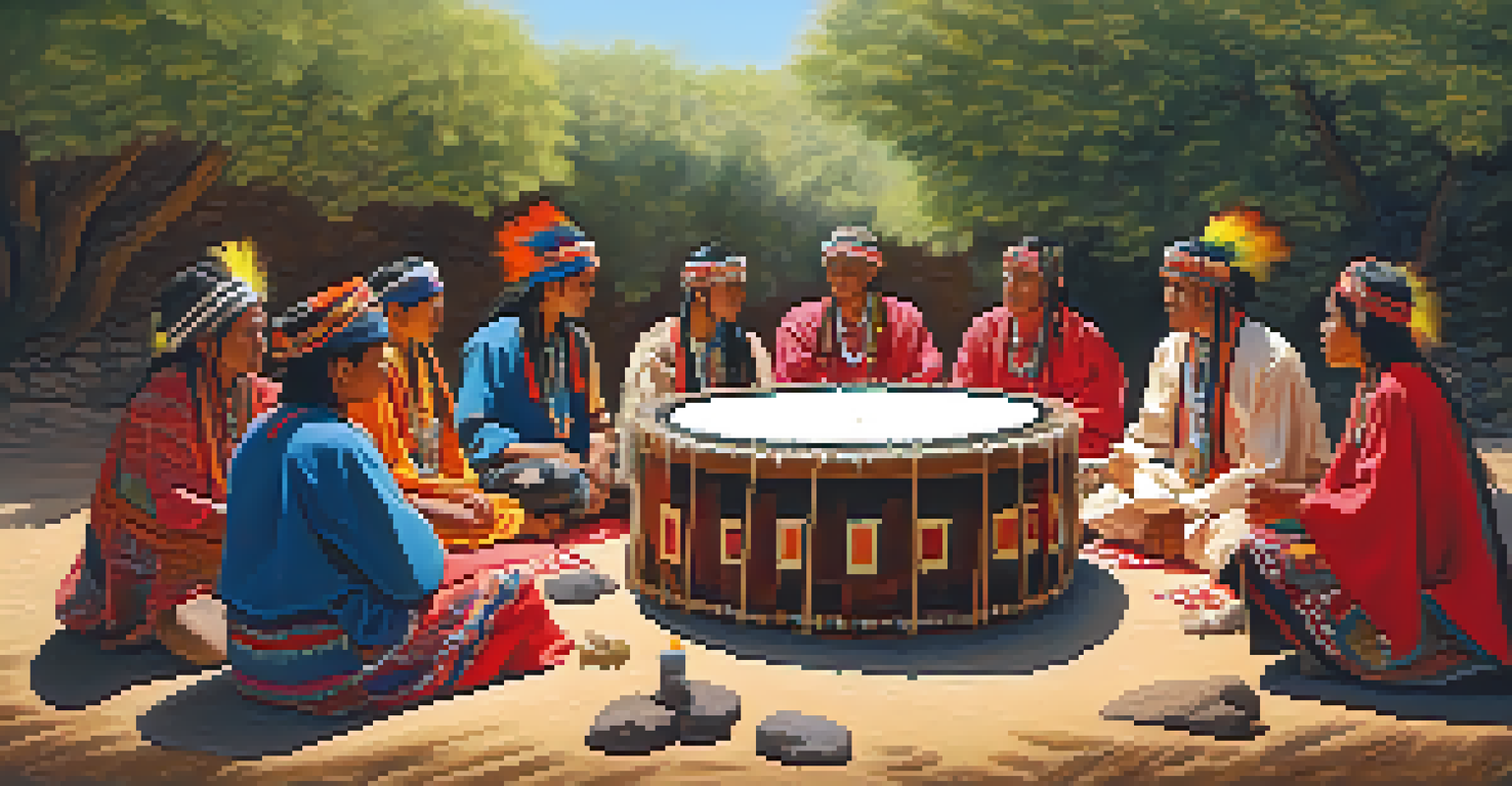Understanding Peyote: Cultural Significance in Healing Rituals

What is Peyote? An Overview of the Cactus
Peyote is a small, spineless cactus native to the southwestern United States and Mexico. Known scientifically as Lophophora williamsii, this unique plant has been used for thousands of years, particularly by Indigenous peoples. Its psychoactive properties primarily come from mescaline, a compound that induces altered states of consciousness.
The use of Peyote is not just about the plant; it's about a journey of the spirit and a bridge to the sacred.
The cactus is typically consumed in the form of dried buttons, which can be chewed, brewed into tea, or taken in powdered form. These preparations lead to intense visual and auditory experiences that many users describe as spiritual or transformative. It's important to note that Peyote is often used in a ceremonial context rather than for recreational purposes.
Understanding Peyote requires recognizing its role not just as a substance, but as a symbol of cultural identity and heritage. The cactus is deeply woven into the spiritual practices of various Indigenous tribes, highlighting the need to respect its sacredness and the traditions surrounding its use.
Historical Context of Peyote in Indigenous Cultures
The use of Peyote in Indigenous cultures dates back to ancient times, with archaeological evidence suggesting its use for over 5,000 years. Tribes such as the Huichol and the Navajo have long regarded this cactus as a powerful tool for healing and spiritual connection. The rituals surrounding Peyote use are often tied to their cosmologies and understanding of the universe.

For these communities, Peyote is not merely a plant; it represents a bridge between the material world and the spiritual realm. Ceremonies involving Peyote often include prayer, song, and communal gatherings, fostering a sense of unity and shared purpose among participants. These practices reflect a holistic approach to healing that encompasses physical, emotional, and spiritual wellness.
Cultural Significance of Peyote
Peyote serves as a vital symbol of cultural identity and spiritual practices among Indigenous peoples, used primarily in ceremonial contexts.
Additionally, the historical significance of Peyote has led to its recognition within broader social movements. The Native American Church, which emerged in the early 20th century, advocates for the legal use of Peyote in religious ceremonies, emphasizing its importance in preserving cultural identity and spiritual practices.
Peyote in Healing Rituals: A Spiritual Journey
Healing rituals involving Peyote often focus on personal transformation and spiritual growth. Participants may seek guidance, clarity, or a deeper understanding of their life's path. The process typically involves a ceremonial setting, where a guide or shaman leads the participants through the experience, ensuring safety and support.
To understand Peyote is to respect the traditions and the people who have revered it for thousands of years.
During these rituals, individuals often engage in introspection and visualization, which can lead to profound insights and emotional release. The altered state induced by Peyote allows participants to confront inner fears, trauma, or unresolved issues, facilitating a form of healing that goes beyond conventional therapy. Many report feeling a renewed sense of purpose and connection to themselves and others.
Moreover, the communal aspect of these rituals strengthens relationships and fosters a sense of belonging. Participants share their experiences and insights, creating a supportive environment that can enhance the healing process. This collective journey underscores the idea that healing is not just an individual endeavor, but a communal one.
Cultural Misunderstandings and Stereotypes
Despite its rich cultural significance, Peyote is often misunderstood and surrounded by stereotypes. Popular culture sometimes portrays its use as purely recreational, overshadowing its deep spiritual roots. This misrepresentation can lead to a lack of respect for the traditions and practices of Indigenous peoples who hold Peyote sacred.
Additionally, the stigma attached to psychoactive substances can cloud public perception. Many people may not recognize that Peyote's use is primarily for spiritual and healing purposes, rather than for escapism. Misunderstanding its role can perpetuate harmful narratives that dismiss Indigenous practices and their importance in contemporary society.
Legal Challenges for Peyote Use
While Peyote is classified as a controlled substance in the U.S., its use is legally permitted for members of the Native American Church, highlighting ongoing struggles for Indigenous rights.
It's crucial to approach the topic of Peyote with an open mind and a willingness to learn. By understanding the cultural context and respecting the traditions surrounding its use, we can foster a more accurate and respectful dialogue about this powerful plant and its role in healing.
Legal Status of Peyote: Navigating Regulations
The legal status of Peyote varies significantly across different regions, often influenced by cultural and historical contexts. In the United States, Peyote is classified as a Schedule I controlled substance, which means it is illegal to possess or use outside of specific religious contexts. However, members of the Native American Church are legally permitted to use Peyote for religious ceremonies.
This legal framework highlights the ongoing struggle for Indigenous rights and the recognition of cultural practices. Many advocates argue that the legal system should better accommodate the spiritual use of Peyote, emphasizing its importance in maintaining cultural heritage. The conversation around Peyote's legality often intersects with broader discussions about Indigenous sovereignty and the preservation of traditional practices.
As societal attitudes shift towards more inclusive approaches to spirituality and healing, there may be opportunities to reassess the legal restrictions surrounding Peyote. This potential for change could pave the way for greater understanding and respect for Indigenous traditions and their rightful place in contemporary society.
The Role of Modern Science in Understanding Peyote
In recent years, modern science has taken a keen interest in the study of Peyote and its psychoactive component, mescaline. Research has begun to explore the potential therapeutic benefits of Peyote in treating conditions such as depression, anxiety, and PTSD. These studies aim to bridge the gap between traditional Indigenous knowledge and contemporary medical practices.
Clinical studies are investigating how Peyote can facilitate emotional healing and provide insights into the human psyche. Researchers are particularly interested in the ways that the altered states of consciousness induced by Peyote can lead to breakthroughs in personal understanding and emotional release. This scientific exploration may validate the long-held beliefs of Indigenous peoples about the healing powers of Peyote.
Scientific Interest in Peyote
Modern research is exploring Peyote's therapeutic potential, particularly in treating mental health conditions, while emphasizing the need for collaboration with Indigenous communities.
However, it's essential to approach this research with sensitivity and respect for Indigenous cultural practices. The scientific community must prioritize collaboration with Indigenous leaders and communities to ensure that their knowledge and traditions are honored. This partnership can help foster a more holistic understanding of Peyote and its role in healing.
Peyote Today: Cultural Resurgence and Awareness
As awareness of Indigenous cultures and their practices grows, there is a resurgence of interest in Peyote and its significance. Many people are beginning to recognize the importance of preserving traditional practices and the knowledge associated with Peyote use. This cultural revival is empowering Indigenous communities to reclaim their heritage and educate others about their spiritual practices.
Workshops, festivals, and educational programs are being organized to share the cultural and spiritual aspects of Peyote. These events often provide opportunities for non-Indigenous individuals to learn about the traditions surrounding Peyote use and to engage in respectful dialogue. This increased visibility helps counter stereotypes and fosters greater appreciation for the complexity of Indigenous spirituality.

Moreover, the conversation around Peyote is expanding to include discussions about mental health and holistic healing. Many are beginning to see the value in integrating traditional practices with modern therapeutic approaches. This blending of knowledge emphasizes the importance of community, spirituality, and cultural identity in the journey toward healing.